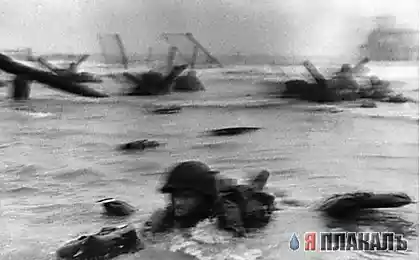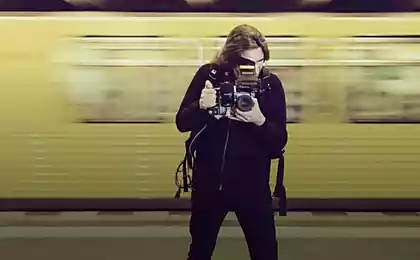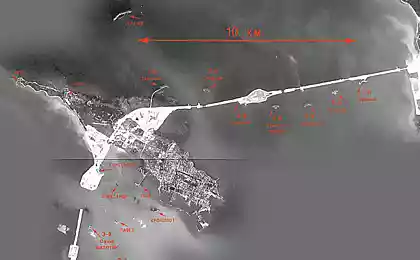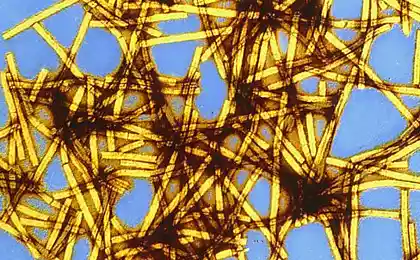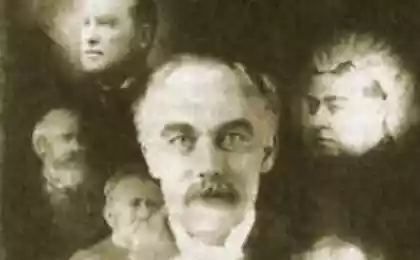1662
In the subcategory of the photos are not for the faint of heart
In the subcategory of the photos are not for the faint of heart, but it is our history
In 1941, the Germans on the Eastern Front took 4 million. Prisoners. Of these, 3 were killed in the first six months of captivity. This is one of the most heinous crimes of the German Nazis. The prisoners were kept in pens months of barbed wire, in the open air, no food, people are eating grass and earthworms. Hunger, thirst, lack of sanitation, deliberately arranged the Germans were doing their job. This mass murder was against the customs of war, against the economic needs of Germany. Pure ideology - the more sub-humans die, the better.
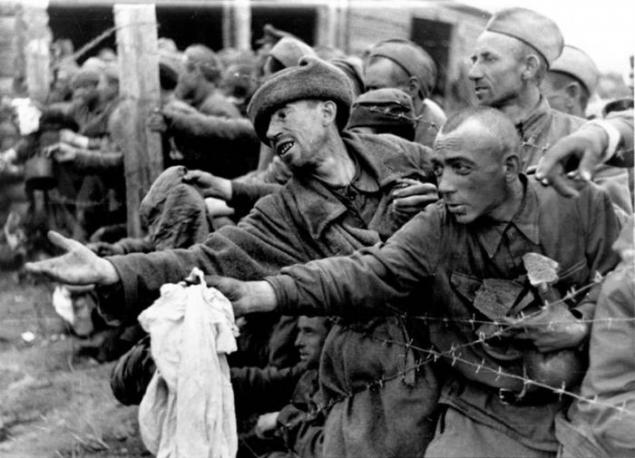
Minsk. July 5, 1942 POW camp "Blackbird." The consequences of Minsk and Bialystok boiler 140 thousand 9 hectares in the open air.
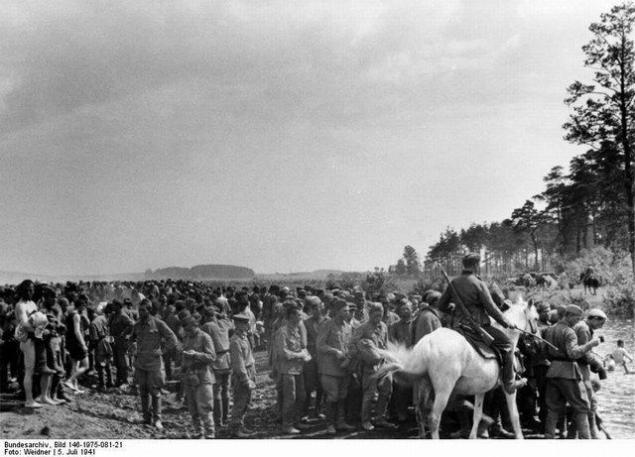
Minsk, August 1941 Himmler came to see the prisoners. A very strong image. Looking prisoners and SS looks beyond the thorns ...
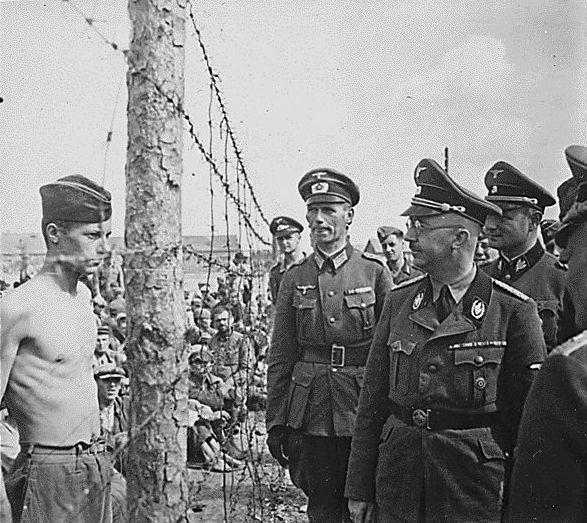
June 1941 District of Rasseynyay (Lithuania). The crew of the KV-1 captured. Tanker centered on Budanov's like ... It's the 3rd Mechanized Corps, they met at the border war. The 2-day tank battle in Lithuania 23-24.06.1941 body was broken.
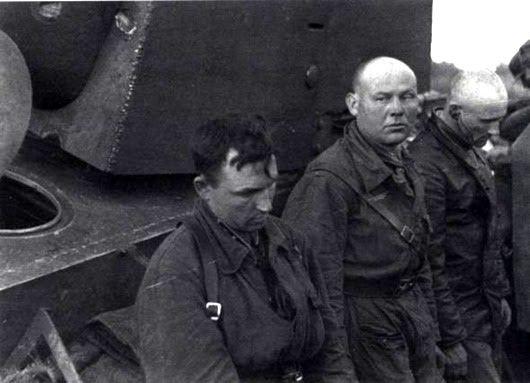
Vinnitsa, July 28, 1941 Since the prisoners were fed little, he tried to help the local people. Ukrainian women with baskets, plates at the gate of the camp ...
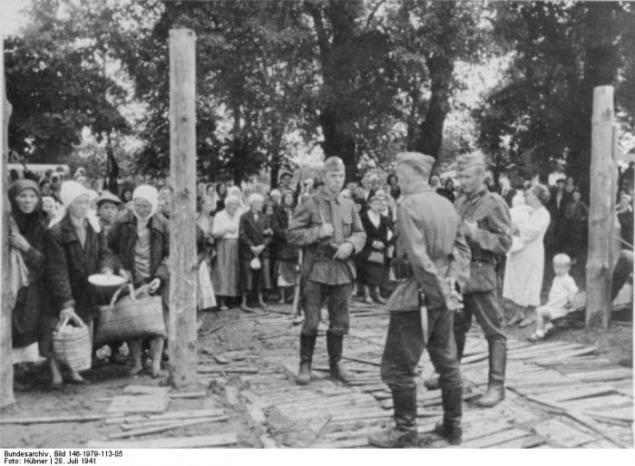
Ibid. Apparently, security is still allowed to pass food for thorn.
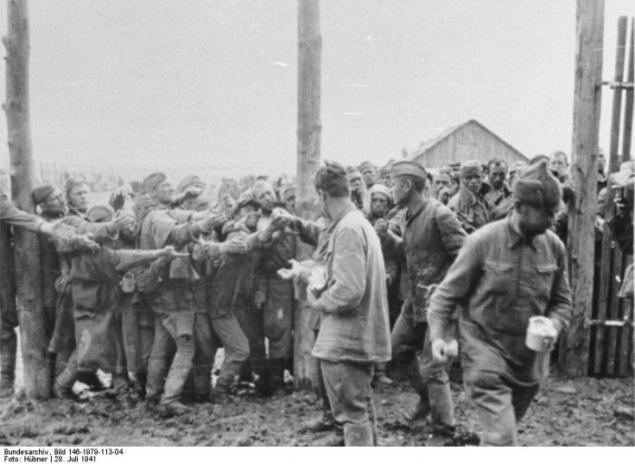
August 1941 The concentration camp "Uman pit." He Stalag (collecting camp) № 349. It was constructed in the career of a brick factory in Uman (Ukraine). In the summer of 41-th is kept prisoners from Uman boiler 50 000 people. Under the open sky, in the paddock.
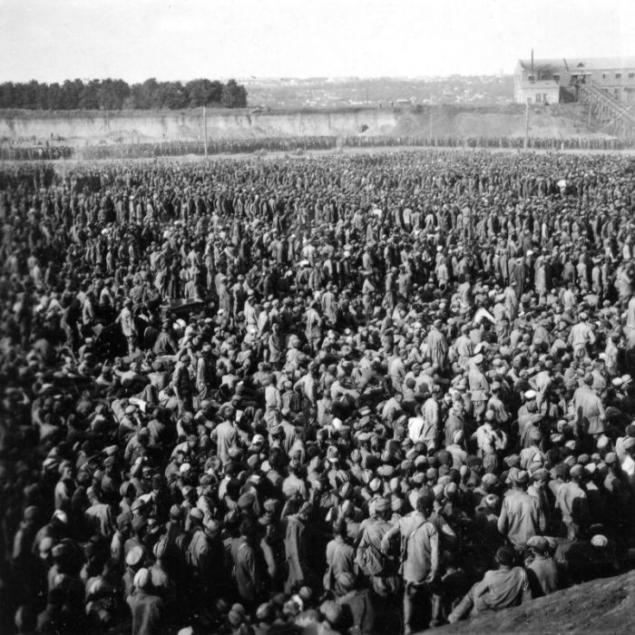
"The wounded and shell-shocked, I was captured. Among the first was in Uman pit. Above, I could see the pit still empty. No shelter, no food, no water. The sun beats down mercilessly. In the western corner of the basement pit was a puddle of brownish-green water with fuel oil. We rushed to her, drew the muck caps, rusty cans, just his hands and drank greedily. Yet I remembered two horses tied to a post. Five minutes from these horses have nothing left. " (Vasily Mishchenko, a former prisoner of "Pit»)
Vasily Mishchenko was a lieutenant when he was captured in Uman boiler. But coppers got not only the soldiers and junior officers. And generals too. In the photo: the generals Ponedelin and Kirillov, they commanded the Soviet forces near Uman:
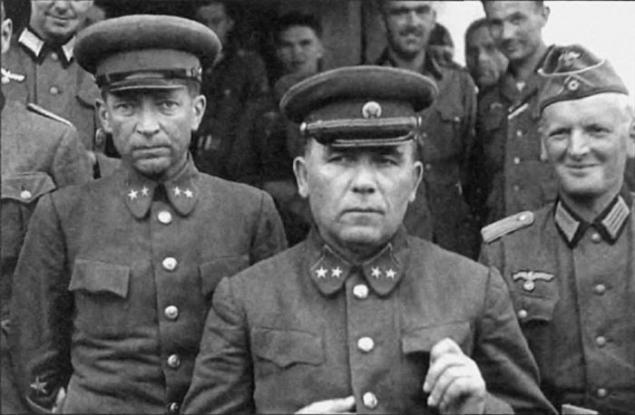
This photo the Germans used for propaganda leaflets. The Germans are smiling, but at the general Kirillov (left, wearing a cap with a star torn) look very sad ... No good, this photo session promises.
More Ponedelin and Kirillov. Lunch in captivity.
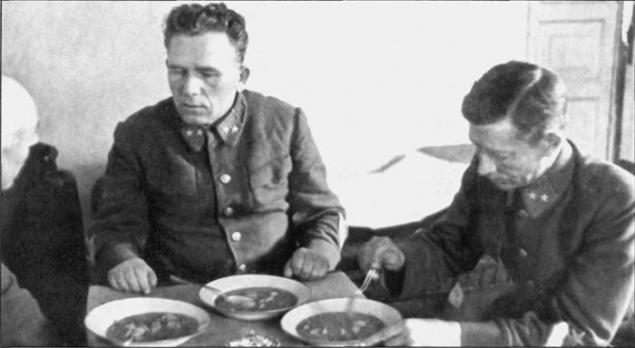
In 1941, the two generals were sentenced in absentia to death as traitors. Before 1945, we were in the camps in Germany, to join the army Vlasov refused to exempt Americans. Transferred to the USSR. Where and shot. In 1956, both rehabilitated.
It is clear that any traitors they are. Forced staged photo - not their fault. The only thing they can blame - in the incompetent. Dali surround yourself in the boiler. They are not alone here. Future Marshals Konev and Eremenko ditched two fronts in Vyazma boiler (October 1941, 700 thousand prisoners) and Baghramyan Tymoshenko - the whole of South-Western Front in Kharkov boiler (May 1942 was 300 thousand. Prisoners). Zhukov, of course, the whole front in the boilers did not get, but for example, in command of the Western Front in the winter 1941-42. Army couple (33rd and 39th) in an environment still driven.
Vyazemskij boiler October 1941 While the generals learned to fight, the endless columns of prisoners were on the roads.
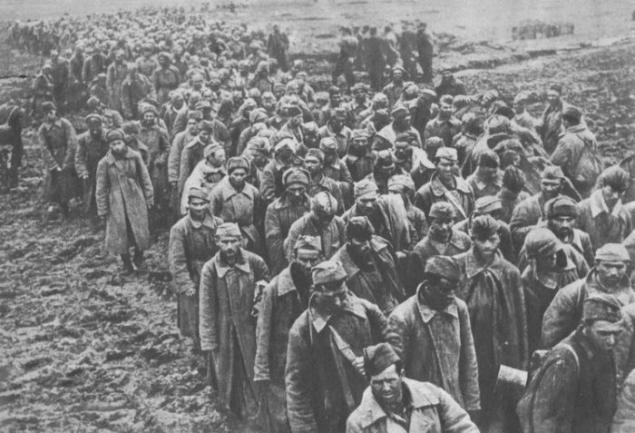
Vyazma, November 1941 Notorious dulag-184 (transit camp) at Kronstadt street. The mortality rate here reaches 200-300 people a day. The dead simply thrown into the pit.
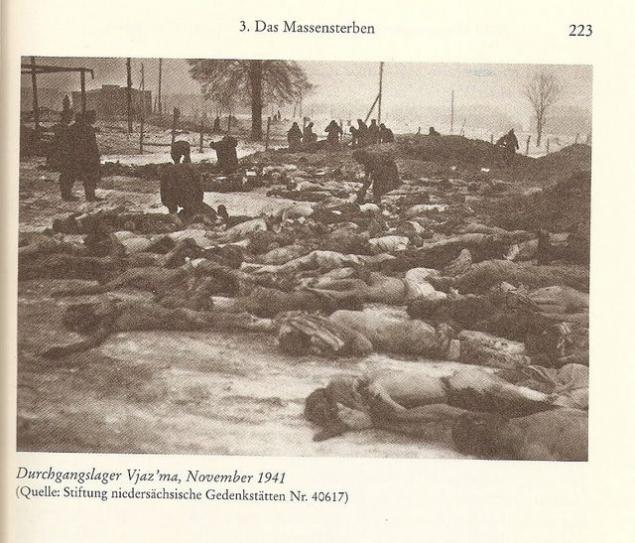
In the ditches dulaga-184 buried about 15 000 people. Memorial them no. Moreover, the site of the concentration camp in the Soviet era was built ... meat-packing plant. He stands there to this day. Relatives of the dead prisoners regularly come here and made their memorial on the fence plant.
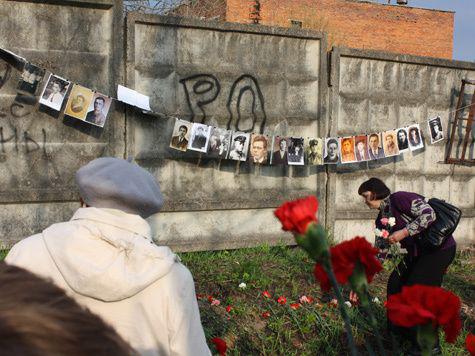
Stalag 10D (Wietzendorf, Germany), the fall of 1941 Corpses of dead Soviet prisoners thrown from the wagon.
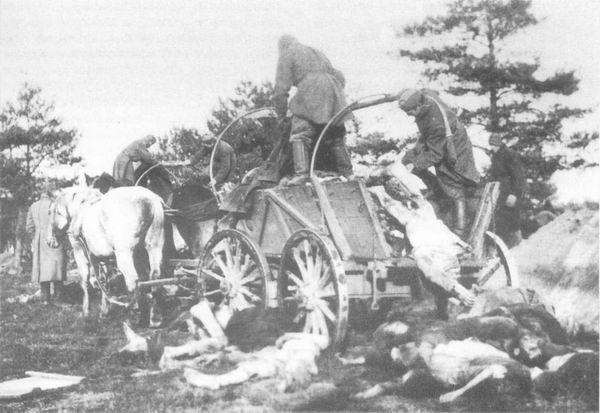
In the fall of 1941 was the mass death of prisoners. It added the cold hunger, epidemic typhus (he carried the lice). There were cases of cannibalism.
November 1941, Stalag 305 in Novo-Ukrainka (Kirovograd region.). Here are four:
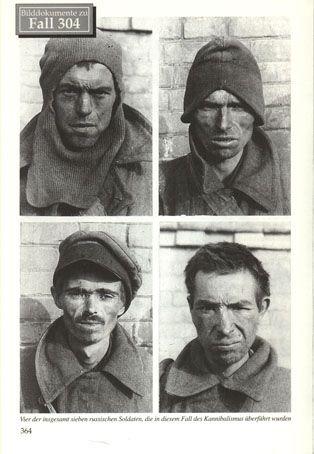
Ate here the corpse of a prisoner:
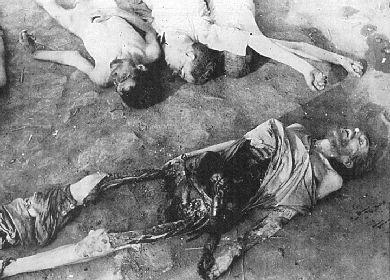
Well, and plus everything - constant bullying camp guard. And not only Germans. According to the memoirs of many true masters of the prisoners in the camp were the so-called Polizei. Ie former prisoners who have passed into the service of the Germans. They beat the prisoners for the slightest offense, taken things performed executions. The most terrible punishment for the police was ... relegation in ordinary prisoners. This meant certain death. Back to the way it was not - only on buck.
of Deblin (Poland), the party of prisoners arrived at Stalag-307. People are in a terrible state. Right - a camp policeman in budenovka (former POW) is the body of the captive who was lying on the platform.
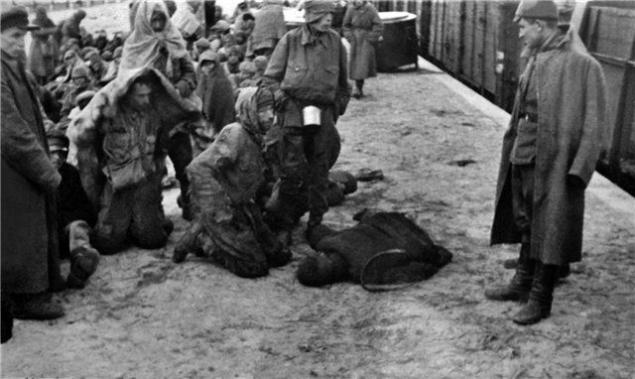
Physical punishment. Two police in Soviet uniform, one holding a captive, the other beaten with a whip or a stick. German in the background - laughs. Another prisoner in the background - is tied to fence posts (also a form of punishment in the camps, the prisoners):
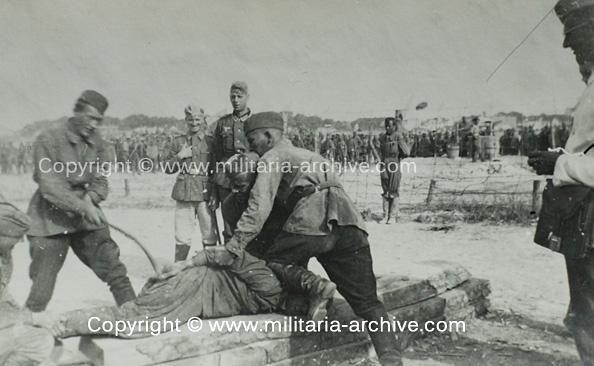
One of the main objectives of the camp was to identify the Jewish policemen and political workers. According to the order "On the commissars" from June 6, 1941, these two categories of prisoners were to be destroyed on the spot. In fact, it was ordered to commit war crimes. Who is not killed immediately upon the capture - those sought in the camps. Why give regular "selection" for the search of Jews and Communists. It was either a general medical check-up with his pants down - the Germans and went looking for the circumcision, or the use of informers among the prisoners themselves.
Alexander Ioselevich, captive surgeon, describes how the selection camp in Jelgava (Latvia) in July 1941 .:
"They brought to the camp biscuits and coffee. Should the SS near the dog, and next to him a prisoner of war. And when people go for the biscuits, he said: "This is a political instructor." Its findings and immediately next shot. Betrayer poured coffee and give two biscuit. "And this - Jude." Hebrew conclusion - shoot, and again to two biscuit. "And this was enkvedistom." His conclusion - shoot, and again to two biscuit ».
Inexpensive appreciated life in the camp in Jelgava 2 biscuit. However, as usual in Russia during the war, somewhere there are people who would not be broken by any shot, and do not buy crackers.
Ukraine, August-September 1941 Soldiers of the 1st Tank Group are preparing to shoot a captive political worker.
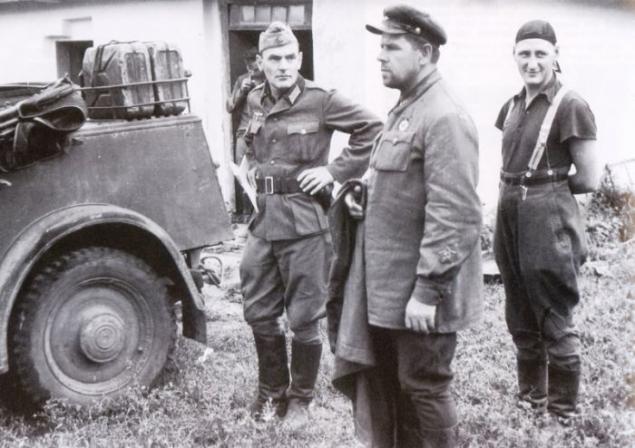
A man holds a dignity. We can say that he - the only man in these photos. Grins Fritz, who shot an unarmed prisoner, it can hardly be classified as such.
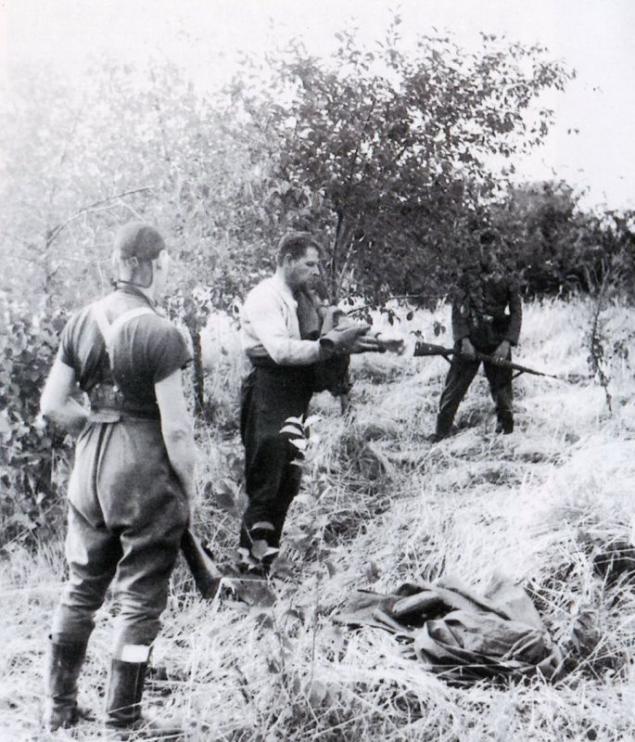
Of course, communist ideology was the false idea that the bright future of it not vyshlo.Odnako largely due to the peasants so that's the Red Army from poorly managed mass turned to 1944, the best army in the world. Which explained in detail "Aryans" from Berlin, they are greatly mistaken considering himself "superior race».
However, in 1941, before the Victory it was still far off. Prisoners had to go through all the circles of hell. Including the most notorious death camps.
Auschwitz, the arrival of the party Soviet prisoners. How many people in the 41-year was back in Budyonny caps ...
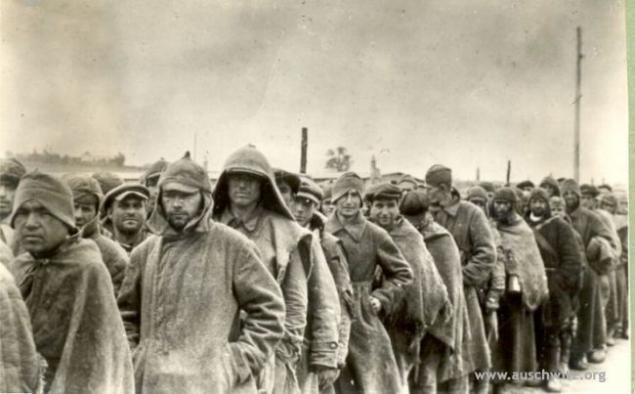
September 3, 1941 to a group of Soviet prisoners of war was first tested gas "Zyklon B". The experiment was conducted in the camp morgue at crematorium №1.
Auschwitz commandant Rudolf Hoess:
"Hardest hit in the memory 900 Russian gassing in the old crematorium, because the use of the block 11 has been hampered ... Russian was forced to undress in the hallway, and they quietly went to the morgue, because they were told it would be done against lice sanitation. All transport, so was in the morgue. The door was locked and let the gas through the holes. How long did the killing, I do not know ... At start-up, someone shouted: "Gas!" In response and there was a howling knock on two doors. But they withstood the pressure. Only a few hours later opened and aired. The first time I saw the corpses of the dead from the gas suffocation in such an amount ... I have to admit that this gassing effect on me reassuringly as soon was to begin the mass extermination of the Jews, and neither Eichmann nor I was not clear in what way to carry out this destruction in the expected scale. When using gas, and both of? Now we find gas and a method of use ».
April 16, 1947. The same Rudolf Hoess, who gassing of Soviet prisoners acted soothingly. He was hanged just opposite the very crematorium, where the murder was committed.
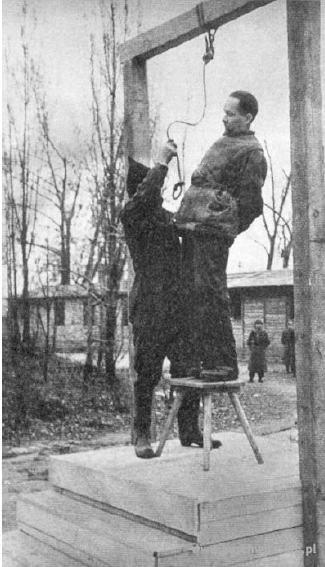
Soviet prisoners of war were also in a concentration camp at Dachau. In this camp in Bavaria we conducted experiments on people. German medical students undergo practical training - doing surgery to healthy people. Also looking for a cure for malaria, infected prisoners, then tried different drugs. By order of the German Air Force conducted experiments on a height limit pilot jumped out with a parachute, it can survive in the thin air. They took the prisoner camp, hung in a special chamber, where evacuated. Most experimental died from a brain haemorrhage.
Soviet prisoners - the object of medical experiments at Dachau.
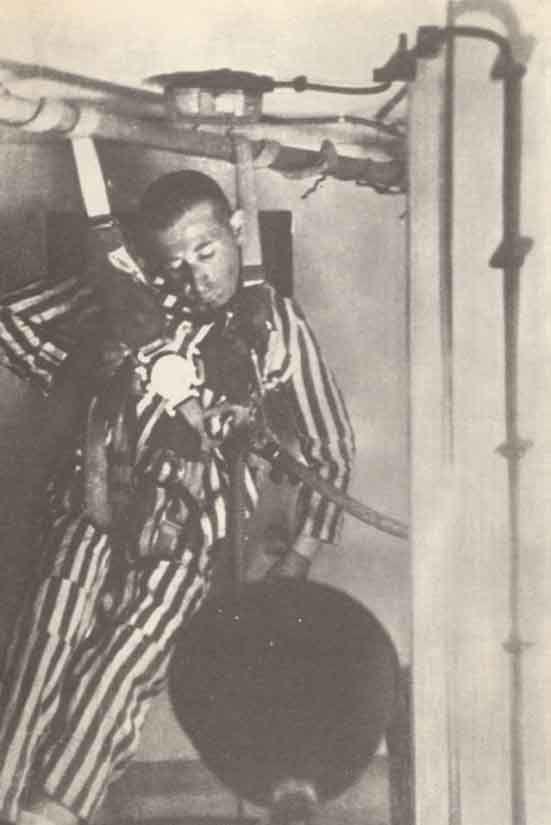
Ibid.
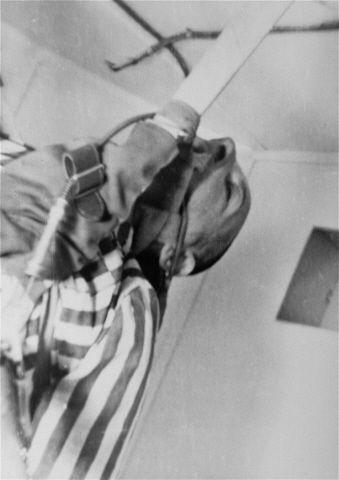
By the end of the war, when the defeat of Germany went on all fronts, the attitude of the Germans to the Soviet prisoners of war was particularly brutal. Alfred Shtreym (West German prosecutor - Nazi hunter after the war), described an incident that occurred in the Stutthof concentration camp near Danzig (Gdansk) at the end of the war:
"In the Stutthof concentration camp in 1944 killed five Russian senior officers, including a woman, Major. They were taken to the crematorium - the place of execution. Initially led men and shot one by one. Then - a woman. According to the Poles, who worked in the crematorium and understand the Russian language, the SS man, who spoke in Russian, mocked the woman, forcing his team to carry out "right, left, circle ..." Then the SS man asked her, "Why did you do that? "What she did, I never knew. She replied that she did it for the country. Thereafter, the SS slapped across the face and said: "It's for your homeland." Russian spat in his eyes and said: "And this is for your homeland." There was confusion. To the woman ran two SS men and began to push her to live in the furnace for burning corpses. She resisted. We ran a few SS men. The officer shouted: "In the furnace of her!" The oven door was open, and because of the heat of the woman's hair caught fire. Despite the fact that the woman resisted vigorously, put it on a cart to the burning of corpses and pushed into the oven ».
The name of the Russian female officer, who spat in the face in front of the SS death remained unknown. Stutthof camp was liberated by Soviet troops in the spring of 1945 here now a museum. In the picture - the same camp crematorium furnace.
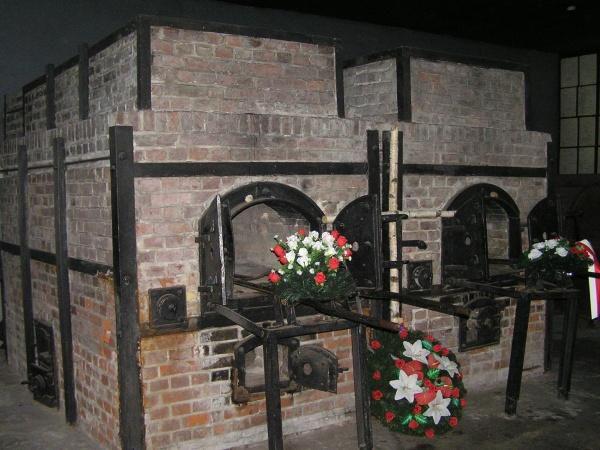
In 1941, the Germans on the Eastern Front took 4 million. Prisoners. Of these, 3 were killed in the first six months of captivity. This is one of the most heinous crimes of the German Nazis. The prisoners were kept in pens months of barbed wire, in the open air, no food, people are eating grass and earthworms. Hunger, thirst, lack of sanitation, deliberately arranged the Germans were doing their job. This mass murder was against the customs of war, against the economic needs of Germany. Pure ideology - the more sub-humans die, the better.

Minsk. July 5, 1942 POW camp "Blackbird." The consequences of Minsk and Bialystok boiler 140 thousand 9 hectares in the open air.

Minsk, August 1941 Himmler came to see the prisoners. A very strong image. Looking prisoners and SS looks beyond the thorns ...

June 1941 District of Rasseynyay (Lithuania). The crew of the KV-1 captured. Tanker centered on Budanov's like ... It's the 3rd Mechanized Corps, they met at the border war. The 2-day tank battle in Lithuania 23-24.06.1941 body was broken.

Vinnitsa, July 28, 1941 Since the prisoners were fed little, he tried to help the local people. Ukrainian women with baskets, plates at the gate of the camp ...

Ibid. Apparently, security is still allowed to pass food for thorn.

August 1941 The concentration camp "Uman pit." He Stalag (collecting camp) № 349. It was constructed in the career of a brick factory in Uman (Ukraine). In the summer of 41-th is kept prisoners from Uman boiler 50 000 people. Under the open sky, in the paddock.

"The wounded and shell-shocked, I was captured. Among the first was in Uman pit. Above, I could see the pit still empty. No shelter, no food, no water. The sun beats down mercilessly. In the western corner of the basement pit was a puddle of brownish-green water with fuel oil. We rushed to her, drew the muck caps, rusty cans, just his hands and drank greedily. Yet I remembered two horses tied to a post. Five minutes from these horses have nothing left. " (Vasily Mishchenko, a former prisoner of "Pit»)
Vasily Mishchenko was a lieutenant when he was captured in Uman boiler. But coppers got not only the soldiers and junior officers. And generals too. In the photo: the generals Ponedelin and Kirillov, they commanded the Soviet forces near Uman:

This photo the Germans used for propaganda leaflets. The Germans are smiling, but at the general Kirillov (left, wearing a cap with a star torn) look very sad ... No good, this photo session promises.
More Ponedelin and Kirillov. Lunch in captivity.

In 1941, the two generals were sentenced in absentia to death as traitors. Before 1945, we were in the camps in Germany, to join the army Vlasov refused to exempt Americans. Transferred to the USSR. Where and shot. In 1956, both rehabilitated.
It is clear that any traitors they are. Forced staged photo - not their fault. The only thing they can blame - in the incompetent. Dali surround yourself in the boiler. They are not alone here. Future Marshals Konev and Eremenko ditched two fronts in Vyazma boiler (October 1941, 700 thousand prisoners) and Baghramyan Tymoshenko - the whole of South-Western Front in Kharkov boiler (May 1942 was 300 thousand. Prisoners). Zhukov, of course, the whole front in the boilers did not get, but for example, in command of the Western Front in the winter 1941-42. Army couple (33rd and 39th) in an environment still driven.
Vyazemskij boiler October 1941 While the generals learned to fight, the endless columns of prisoners were on the roads.

Vyazma, November 1941 Notorious dulag-184 (transit camp) at Kronstadt street. The mortality rate here reaches 200-300 people a day. The dead simply thrown into the pit.

In the ditches dulaga-184 buried about 15 000 people. Memorial them no. Moreover, the site of the concentration camp in the Soviet era was built ... meat-packing plant. He stands there to this day. Relatives of the dead prisoners regularly come here and made their memorial on the fence plant.

Stalag 10D (Wietzendorf, Germany), the fall of 1941 Corpses of dead Soviet prisoners thrown from the wagon.

In the fall of 1941 was the mass death of prisoners. It added the cold hunger, epidemic typhus (he carried the lice). There were cases of cannibalism.
November 1941, Stalag 305 in Novo-Ukrainka (Kirovograd region.). Here are four:

Ate here the corpse of a prisoner:

Well, and plus everything - constant bullying camp guard. And not only Germans. According to the memoirs of many true masters of the prisoners in the camp were the so-called Polizei. Ie former prisoners who have passed into the service of the Germans. They beat the prisoners for the slightest offense, taken things performed executions. The most terrible punishment for the police was ... relegation in ordinary prisoners. This meant certain death. Back to the way it was not - only on buck.
of Deblin (Poland), the party of prisoners arrived at Stalag-307. People are in a terrible state. Right - a camp policeman in budenovka (former POW) is the body of the captive who was lying on the platform.

Physical punishment. Two police in Soviet uniform, one holding a captive, the other beaten with a whip or a stick. German in the background - laughs. Another prisoner in the background - is tied to fence posts (also a form of punishment in the camps, the prisoners):

One of the main objectives of the camp was to identify the Jewish policemen and political workers. According to the order "On the commissars" from June 6, 1941, these two categories of prisoners were to be destroyed on the spot. In fact, it was ordered to commit war crimes. Who is not killed immediately upon the capture - those sought in the camps. Why give regular "selection" for the search of Jews and Communists. It was either a general medical check-up with his pants down - the Germans and went looking for the circumcision, or the use of informers among the prisoners themselves.
Alexander Ioselevich, captive surgeon, describes how the selection camp in Jelgava (Latvia) in July 1941 .:
"They brought to the camp biscuits and coffee. Should the SS near the dog, and next to him a prisoner of war. And when people go for the biscuits, he said: "This is a political instructor." Its findings and immediately next shot. Betrayer poured coffee and give two biscuit. "And this - Jude." Hebrew conclusion - shoot, and again to two biscuit. "And this was enkvedistom." His conclusion - shoot, and again to two biscuit ».
Inexpensive appreciated life in the camp in Jelgava 2 biscuit. However, as usual in Russia during the war, somewhere there are people who would not be broken by any shot, and do not buy crackers.
Ukraine, August-September 1941 Soldiers of the 1st Tank Group are preparing to shoot a captive political worker.

A man holds a dignity. We can say that he - the only man in these photos. Grins Fritz, who shot an unarmed prisoner, it can hardly be classified as such.

Of course, communist ideology was the false idea that the bright future of it not vyshlo.Odnako largely due to the peasants so that's the Red Army from poorly managed mass turned to 1944, the best army in the world. Which explained in detail "Aryans" from Berlin, they are greatly mistaken considering himself "superior race».
However, in 1941, before the Victory it was still far off. Prisoners had to go through all the circles of hell. Including the most notorious death camps.
Auschwitz, the arrival of the party Soviet prisoners. How many people in the 41-year was back in Budyonny caps ...

September 3, 1941 to a group of Soviet prisoners of war was first tested gas "Zyklon B". The experiment was conducted in the camp morgue at crematorium №1.
Auschwitz commandant Rudolf Hoess:
"Hardest hit in the memory 900 Russian gassing in the old crematorium, because the use of the block 11 has been hampered ... Russian was forced to undress in the hallway, and they quietly went to the morgue, because they were told it would be done against lice sanitation. All transport, so was in the morgue. The door was locked and let the gas through the holes. How long did the killing, I do not know ... At start-up, someone shouted: "Gas!" In response and there was a howling knock on two doors. But they withstood the pressure. Only a few hours later opened and aired. The first time I saw the corpses of the dead from the gas suffocation in such an amount ... I have to admit that this gassing effect on me reassuringly as soon was to begin the mass extermination of the Jews, and neither Eichmann nor I was not clear in what way to carry out this destruction in the expected scale. When using gas, and both of? Now we find gas and a method of use ».
April 16, 1947. The same Rudolf Hoess, who gassing of Soviet prisoners acted soothingly. He was hanged just opposite the very crematorium, where the murder was committed.

Soviet prisoners of war were also in a concentration camp at Dachau. In this camp in Bavaria we conducted experiments on people. German medical students undergo practical training - doing surgery to healthy people. Also looking for a cure for malaria, infected prisoners, then tried different drugs. By order of the German Air Force conducted experiments on a height limit pilot jumped out with a parachute, it can survive in the thin air. They took the prisoner camp, hung in a special chamber, where evacuated. Most experimental died from a brain haemorrhage.
Soviet prisoners - the object of medical experiments at Dachau.

Ibid.

By the end of the war, when the defeat of Germany went on all fronts, the attitude of the Germans to the Soviet prisoners of war was particularly brutal. Alfred Shtreym (West German prosecutor - Nazi hunter after the war), described an incident that occurred in the Stutthof concentration camp near Danzig (Gdansk) at the end of the war:
"In the Stutthof concentration camp in 1944 killed five Russian senior officers, including a woman, Major. They were taken to the crematorium - the place of execution. Initially led men and shot one by one. Then - a woman. According to the Poles, who worked in the crematorium and understand the Russian language, the SS man, who spoke in Russian, mocked the woman, forcing his team to carry out "right, left, circle ..." Then the SS man asked her, "Why did you do that? "What she did, I never knew. She replied that she did it for the country. Thereafter, the SS slapped across the face and said: "It's for your homeland." Russian spat in his eyes and said: "And this is for your homeland." There was confusion. To the woman ran two SS men and began to push her to live in the furnace for burning corpses. She resisted. We ran a few SS men. The officer shouted: "In the furnace of her!" The oven door was open, and because of the heat of the woman's hair caught fire. Despite the fact that the woman resisted vigorously, put it on a cart to the burning of corpses and pushed into the oven ».
The name of the Russian female officer, who spat in the face in front of the SS death remained unknown. Stutthof camp was liberated by Soviet troops in the spring of 1945 here now a museum. In the picture - the same camp crematorium furnace.












